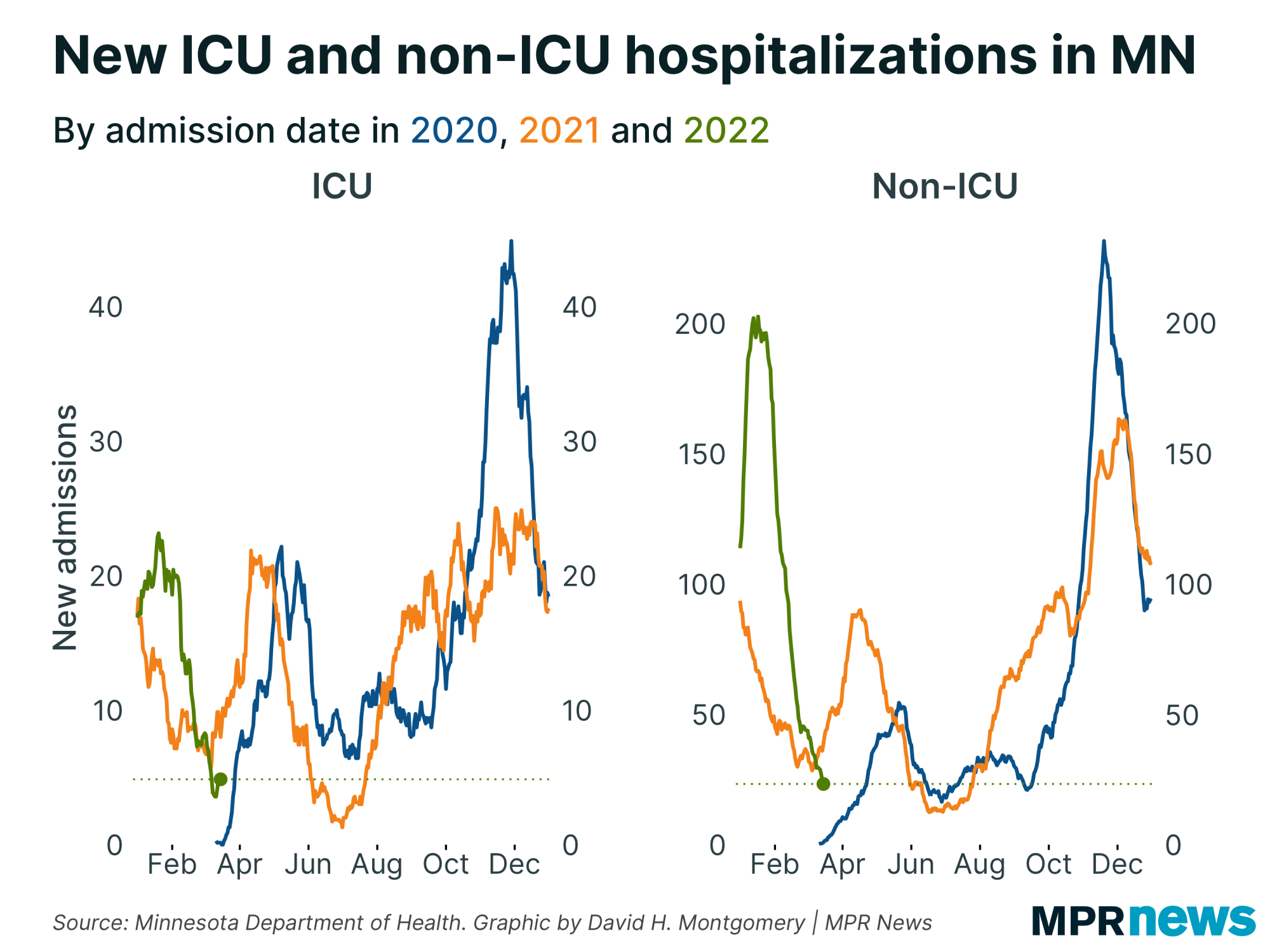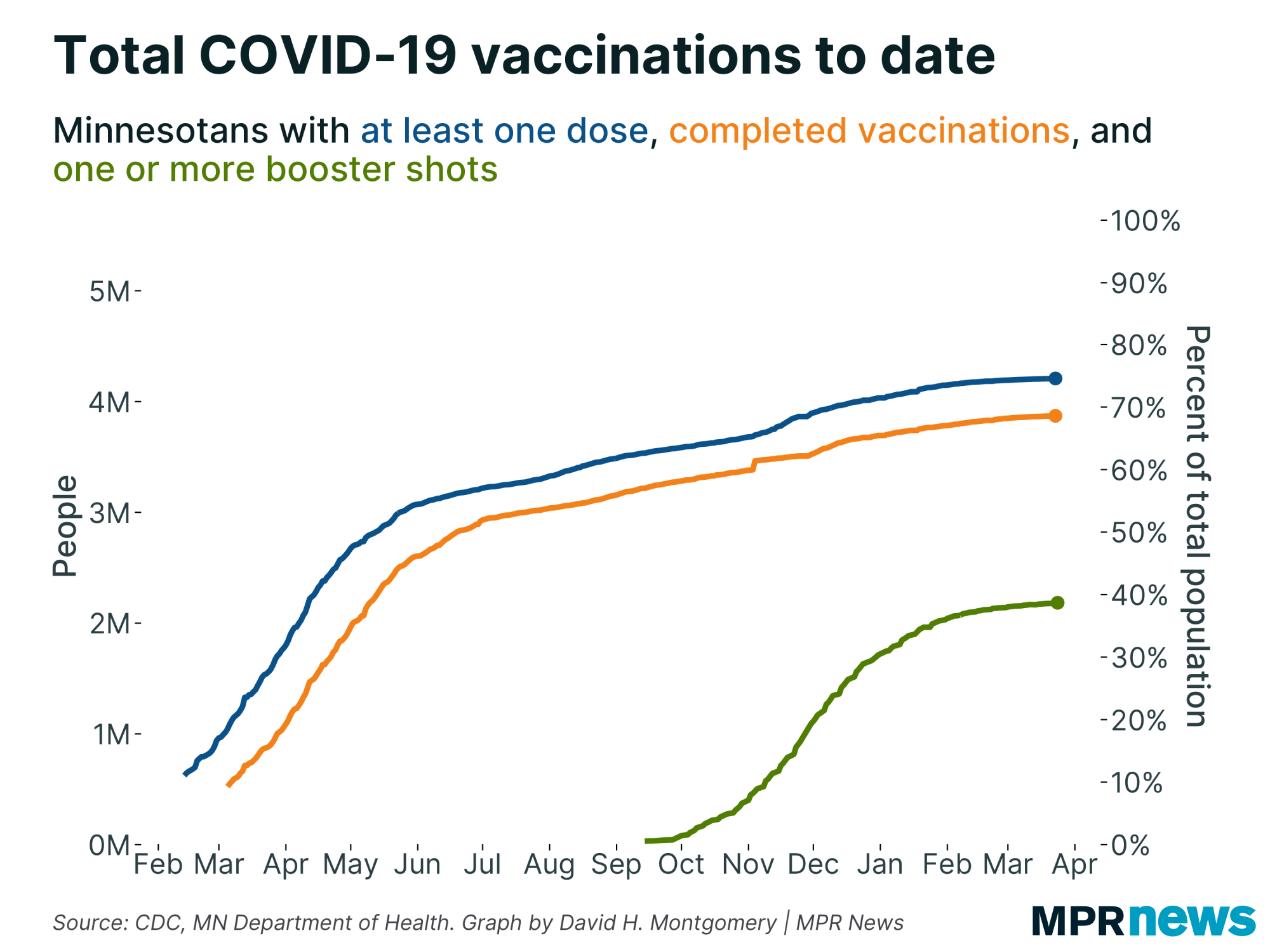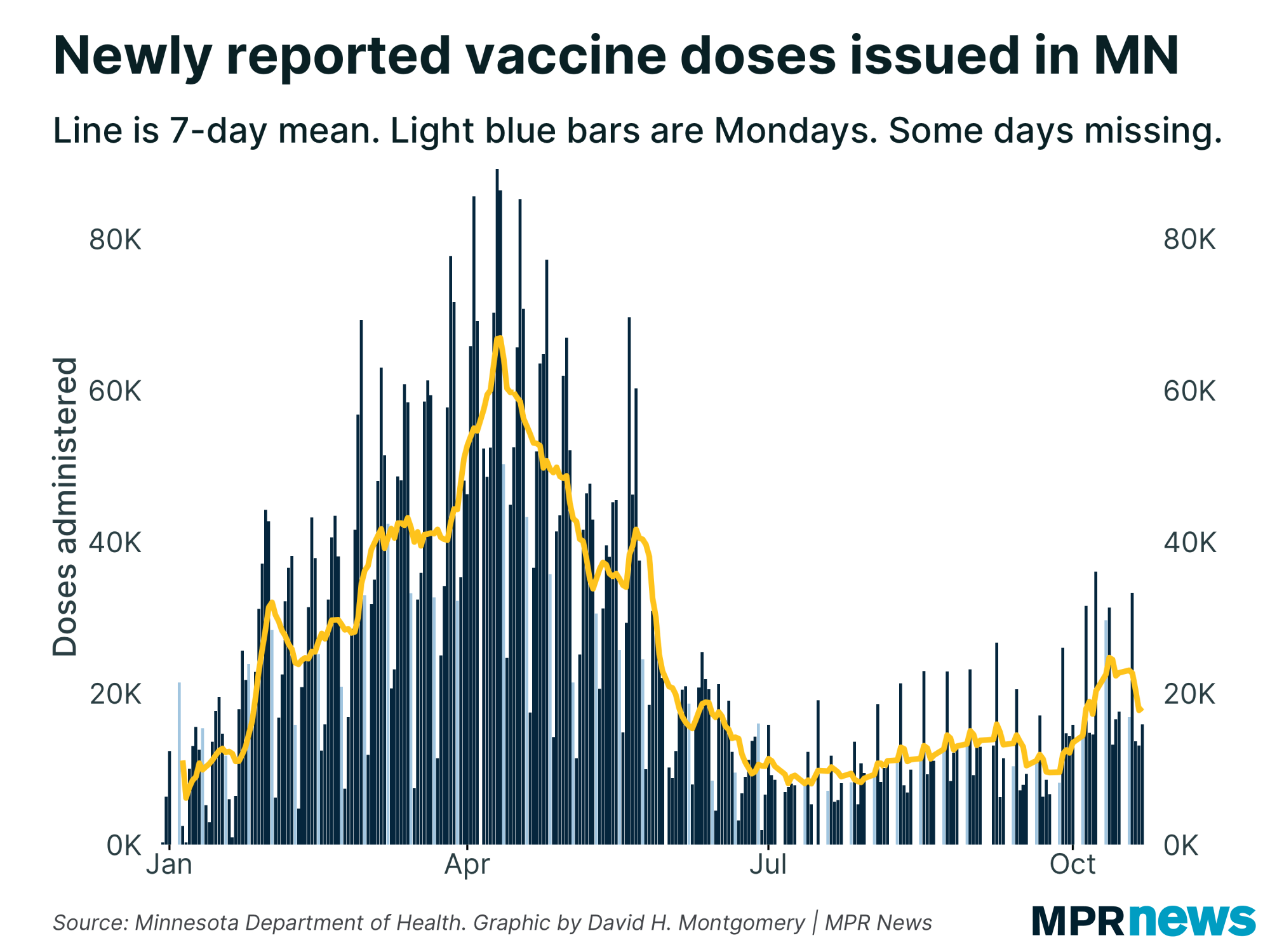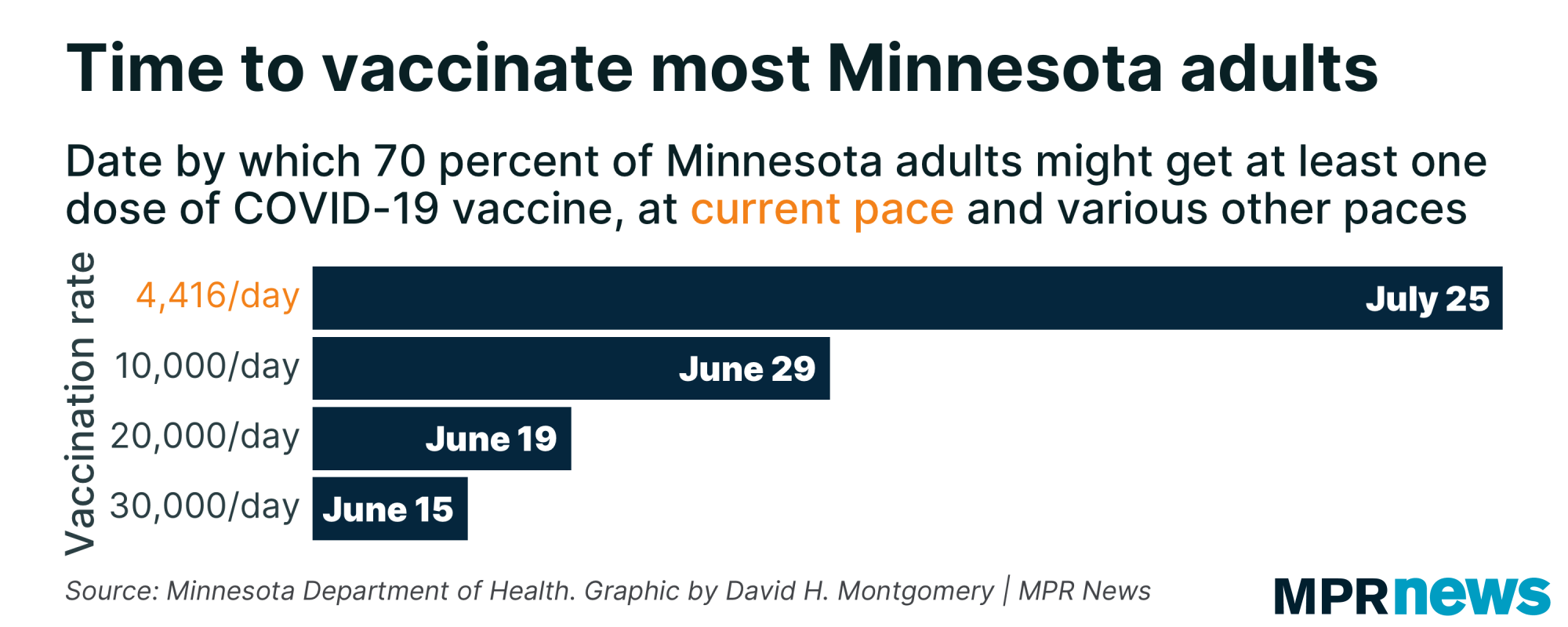May 14 update on COVID-19 in MN: Pandemic trends solid; vaccinations languish

Go Deeper.
Create an account or log in to save stories.
Like this?
Thanks for liking this story! We have added it to a list of your favorite stories.
3 things to know
61.1 percent of Minnesotans 16 and older with at least one vaccine dose; 51.2 percent — more than 2.2 million people — are now completely vaccinated
Active cases trending at six-week low; intensive care hospitalizations down
Walz ends statewide mask-wearing order
Updated 2:51 p.m.
Minnesota’s COVID-19 picture continues to improve following a spring surge, with active caseloads and hospitalizations trending at or near their lowest points in the past six weeks.
As the April wave ebbs, however, state public health leaders continue to stress that the pandemic is not over. Underpinning their concern: The vaccination pace has collapsed in recent weeks and remains at a relative crawl.
It’s not clear how Minnesota’s decision to drop the statewide mask-wearing order as of Friday will affect the vaccination effort going forward. Officials, though, acknowledge they need to do more to get unvaccinated Minnesotans to get their shots.

“The virus is still out there in our community,” state infectious disease director Kris Ehresmann told reporters Friday. “It's still very much a threat to those who are not vaccinated.”
Turn Up Your Support
MPR News helps you turn down the noise and build shared understanding. Turn up your support for this public resource and keep trusted journalism accessible to all.
Ehresmann noted that some settings — particularly health care facilities and public transit — will still require masks, even with the state mandate ended.
Active cases, hospitalizations trending down
Despite the slow vaccination pace, the disease metrics continue to show Minnesota’s spring case surge easing. The new-case trend is running at a little more than 1,000 a day, the lowest it’s been in nearly two months.
The count of known, active COVID-19 cases came in at 10,334 — slightly higher than the past couple of days but still about half its most recent high of around 20,000 in mid-April.

Friday’s report showed 464 people hospitalized with COVID-19 in Minnesota; 123 needed intensive care. Both figures continue to trend down from their recent peaks. New hospital admissions have dropped significantly.

Nine newly reported deaths put Minnesota’s pandemic toll at 7,283. Among those who have died, about 60 percent had been living in long-term care or assisted-living facilities; most had underlying health problems.

The state has recorded 592,750 total confirmed or probable cases so far in the pandemic, including the 1,306 posted Friday. About 97 percent of Minnesotans known to be infected with COVID-19 in the pandemic have recovered to the point where they no longer need to isolate.

Regionally, all parts of Minnesota are in better shape than they were in late November and early December. Case counts had crept up across the state during April, but the trend appears to have peaked.

Officials continue to implore Minnesotans to keep their guard up during proms, graduations and other spring events, noting that more contagious COVID-19 variants are driving new cases across the state.
Youth, young adult counts concerning
While the overall trends are solid, officials are increasingly concerned about the spread of COVID-19 in younger people. They’ve been urging more testing of middle and high school students and weekly testing for athletes, coaches, referees and other youth sports participants.
People in their 20s still make up the age bracket with the state’s largest number of confirmed cases — more than 109,000 since the pandemic began.

The number of high school-age youth confirmed with the disease has also grown, with more than 48,000 15-to-19-year-olds known to be infected during the pandemic.
Although young people are less likely to feel the worst effects of the disease and end up hospitalized, experts worry they will spread it unknowingly to older relatives and members of other vulnerable populations. Those with the COVID-19 virus can spread it when they don’t have symptoms.
Vaccinations stagger forward
About 2.7 million residents 16 and older now have at least one vaccine dose; more than 2.2 million have completed their vaccinations as of Friday’s update.
That works out to 51.2 percent of the 16-and-older population completely vaccinated and more than 61 percent with at least one shot, including 88 percent of those 65 and older.

The vaccination pace has plummeted in recent weeks. Minnesota’s seven-day average rate of new first-dose vaccinations has fallen below 10,000 a day for the first time since Jan. 24.

Minnesota’s looking at some possible incentives to attract those still unvaccinated to get their shots. Walz has broached the idea of free fishing licenses to people who get vaccinated, as a possible idea. “We’ll continue to explore that,” Minnesota Health Commissioner Jan Malcolm told reporters Friday.


Eligible Minnesotans can now walk in for a COVID-19 vaccination without an appointment at the state’s community vaccination program locations.
COVID-19 in Minnesota
Data in these graphs are based on the Minnesota Department of Health's cumulative totals released at 11 a.m. daily. You can find more detailed statistics on COVID-19 at the Health Department website.
Latest developments
Despite new guidance, masks still required in Minnesota school buildings
Minnesota school leaders are reminding families, students and staff that masks are still required in school buildings.
Gov. Tim Walz lifted Minnesota’s mask mandate Friday, but said students and staff need to continue to wear masks through the end of the school year.
Deb Henton, the executive director of the Minnesota Association of School Administrators, said school leaders have been getting angry and concerned emails about the new guidance.
“There’s a fair amount of frustration on the part of our school leaders who’ve had a long year and who’ve held firm and have followed the mandates,” Henton said, “and then we now have something that seems to be contradictory and a really hard message for some of our kids and families to receive.”
Children ages 12 to 15 received federal approval for the Pfizer COVID-19 vaccine earlier this week, while younger students are still not eligible for vaccination.
— Elizabeth Shockman | MPR News
Twins set July 5 for full capacity return to Target Field
The Minnesota Twins will be ready to fill Target Field with fans starting July 5.
Team executives on Thursday announced their plan to return to full capacity as state COVID-19 restrictions recede. They'll be taking a couple steps to reach that goal, after beginning the season with a pandemic cap of 10,000 fans in the stadium that holds nearly 40,000 people.
Starting Friday, May 14, through May 30, the stadium will operate at 60 percent capacity, with tickets still sold in two and four-person pods. That'll rise to 80 percent for games in June, with season-ticket holders allowed to return to their normal seat locations.
And beginning with the July 5 game against the Chicago White Sox, tickets will be available for all seats.
Tickets for games in June and beyond will go on sale May 20.
For now, state mandates still require people to wear face coverings in crowds of more than 500 people. And the Twins said they'll continue to offer a limited number of physically distanced seats for the rest of this season, for people who request them.
Twins CEO Dave St. Peter said in a statement that the team was “absolutely thrilled to begin our measured, responsible and safe ramp up to 100 percent capacity at the ballpark … and we cannot wait to see — and hear — a full house at Target Field.”
— Andrew Krueger | MPR News
Top headlines
Teens jump at appointments, ahead of anticipated COVID-19 vaccine expansion: Middle schoolers across Minnesota are already signing up for COVID-19 vaccine appointments, anticipating that by the end of this week, they’ll be newly eligible to take their first big step toward life as they used to know it.
U.S. advisers endorse Pfizer COVID shot for kids 12 and up: Federal health advisers have endorsed use of Pfizer's COVID-19 vaccine in kids as young as 12. Earlier in the week, the Food and Drug Administration cleared the expanded use of Pfizer's shots, citing evidence the shots worked as well in those 12 to 15 years old as those 16 and older.


